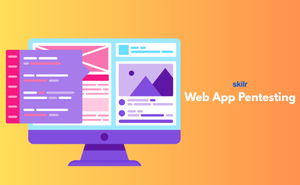👇 CELEBRATE CLOUD SECURITY DAY 👇
00
HOURS
00
MINUTES
00
SECONDS

Think of Web App Pentesting as a health checkup for websites and online platforms. Just like a doctor runs tests to find hidden health issues, penetration testers run simulations to uncover flaws in apps and sites. These tests copy the methods hackers might use, but in a safe and controlled way, so organizations can fix problems before they cause damage.
With businesses relying more on online systems, cyber risks are higher than ever. A certified Web App Pentesting professional proves they can secure apps, protect user information, and keep systems running smoothly. This certification validates skills to identify risks, strengthen defenses, and safeguard organizations against growing cyber threats.
This exam is ideal for:
Domain 1 - Introduction to Web Application Security
Domain 2 - Web Fundamentals for Pentesting
Domain 3 - Common Web Vulnerabilities
Domain 4 - Pentesting Methodologies
Domain 5 - Tools and Frameworks
Domain 6 - Secure Development Practices
Domain 7 - Reporting and Documentation
Domain 8 - Future Scope in Pentesting
Industry-endorsed certificates to strengthen your career profile.
Start learning immediately with digital materials, no delays.
Practice until you’re fully confident, at no additional charge.
Study anytime, anywhere, on laptop, tablet, or smartphone.
Courses and practice exams developed by qualified professionals.
Support available round the clock whenever you need help.
Easy-to-follow content with practice exams and assessments.
Join a global community of professionals advancing their skills.
| Exam Name Web App Pentesting | Exam Code - |
| Exam Duration - | Exam Format - |
| Exam Type | Number of Questions - |
| Eligibility/Pre-Requisite NIL | Exam Validity Live |
| Exam Language English | Pass Score - |
Common ones like SQL injection, XSS, CSRF, broken authentication, and more.
No, it also emphasizes manual testing and understanding attacker strategies.
It’s for cybersecurity professionals, ethical hackers, developers, and anyone interested in web application security.
No, but a basic understanding of networking and web technologies is helpful.
Some knowledge of web development (HTML, JavaScript, SQL) is useful but not mandatory.
Yes, it’s suitable for students and beginners who want to enter cybersecurity.
Banking, IT services, e-commerce, healthcare, government, and any sector using web platforms.
It boosts your profile for roles in ethical hacking, cybersecurity analysis, and web security consulting.
Yes, the certification covers both attacking and defending aspects.
Almost all industries worldwide that deal with online platforms require pentesting expertise.
Yes, with growing cyberattacks and digital transformation, demand will only rise.
Absolutely, it adds strong security knowledge to their profile.
Yes, it’s a great starting point for IT professionals moving into security.
Yes, they can build more secure applications by understanding hacker tactics.
Ethical Hacker, Penetration Tester, Security Analyst, Application Security Engineer, and Security Consultant.